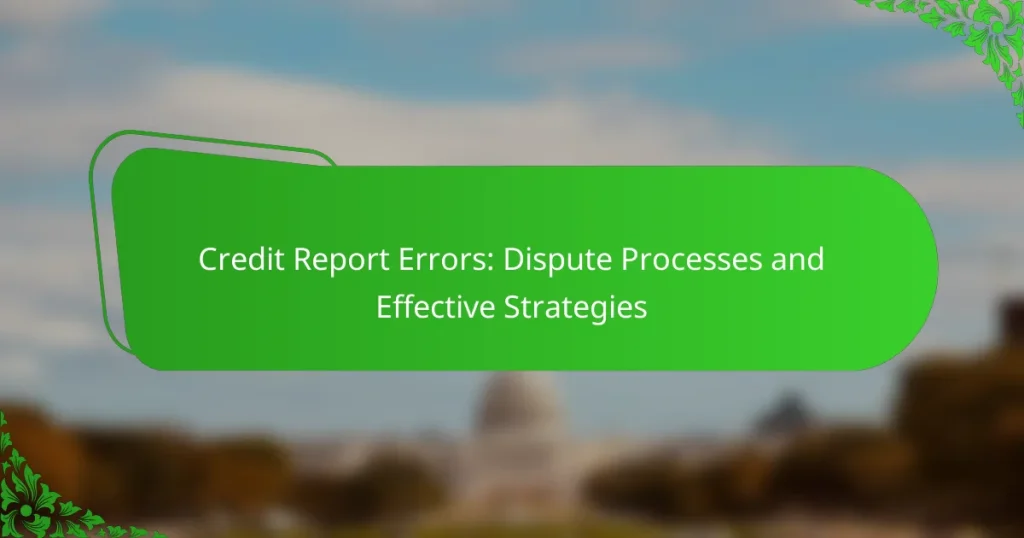
Credit Report Errors: Dispute Processes and Effective Strategies
Disputing credit report errors is a vital process for anyone looking to maintain an accurate…
Personal finance management tools are essential for individuals looking to effectively track their income, expenses, and savings. These tools come with varying features and pricing options, allowing users to choose the best fit for their financial needs. By providing a structured approach to monitoring financial health, they empower users to make informed decisions and achieve their financial goals.

Disputing credit report errors is a vital process for anyone looking to maintain an accurate financial record and a healthy credit score. This involves identifying inaccuracies, gathering necessary documentation, and reaching out to the appropriate parties to resolve the issues. By focusing on clarity, thoroughness, and persistence, you can significantly improve your chances of a…

Negotiating lower interest rates can be a powerful strategy to improve your financial health. By understanding your financial position and leveraging market conditions, you can approach lenders with confidence to secure better rates on loans and credit cards. This process not only reduces borrowing costs but also enhances cash flow and can lead to improved…

Saving for retirement is a crucial aspect of financial planning that requires a strategic approach to investment options, budgeting, and long-term goals. By exploring various investment avenues and creating a comprehensive budget, you can effectively prepare for a comfortable retirement. Careful planning and assessment of your financial needs will help you achieve your desired lifestyle…

Budgeting apps have become essential tools for managing personal finances, offering a range of features to suit various needs. Popular options like Mint, YNAB, and EveryDollar provide functionalities such as expense tracking and budget creation, helping users streamline their financial management. With costs that vary from free to subscription-based models, selecting the right app involves…

When planning for retirement, understanding the differences between a 401(k) and an IRA is crucial for maximizing your savings. Each account has unique benefits, such as contribution limits and tax treatment, which can influence your decision based on your financial goals. This guide will help you determine which option may be better suited for your…

Social Security benefits are a vital component of retirement planning, providing financial support based on an individual’s work history and earnings. To qualify, individuals must meet specific criteria related to age and work credits, making it essential to understand these requirements. The calculation of benefits involves key factors such as Average Indexed Monthly Earnings (AIME)…

When it comes to tackling debt, choosing the right repayment strategy can make a significant difference in your financial journey. The Debt Snowball and Debt Avalanche methods each offer unique advantages, depending on your personal goals and psychological needs. The Snowball method emphasizes quick wins by paying off smaller debts first, while the Avalanche method…

Building credit is crucial for new immigrants in the US as it lays the foundation for financial stability and access to essential services. By employing tailored strategies such as secured credit cards and credit-builder loans, newcomers can establish a positive credit history. Consistent bill payments and responsible credit management further enhance their financial opportunities in…

Maximizing employer contributions is essential for enhancing employee benefits while leveraging tax advantages. By implementing strategies such as 401(k) matching, profit-sharing, and flexible benefits, businesses can foster a more engaged and satisfied workforce. These contributions not only improve financial wellness for employees but also lead to increased retention and productivity, creating a healthier workplace environment….

Saving for a down payment is a crucial step in the homebuying process, typically taking 3 to 5 years depending on your financial situation and the housing market. Establishing a clear budget and tracking your expenses will help you reach your savings goals more effectively. Additionally, exploring various investment options, such as high-yield savings accounts…
The best personal finance management tools help individuals track their income, expenses, and savings effectively. These tools vary in features, usability, and pricing, catering to different financial management needs.
Mint is a popular free personal finance tool that aggregates all your financial accounts in one place. It allows users to track spending, create budgets, and set financial goals, making it easy to monitor your financial health.
One of Mint's standout features is its ability to categorize transactions automatically, providing insights into spending habits. However, users should be aware of potential privacy concerns, as Mint collects data to offer personalized recommendations.
YNAB is a budgeting tool designed to help users allocate every dollar they earn. It operates on the principle of giving each dollar a job, which encourages proactive financial management.
While YNAB requires a subscription, many users find its structured approach effective for reducing debt and saving money. The software offers educational resources, making it suitable for those new to budgeting.
Personal Capital combines budgeting with investment tracking, making it ideal for users looking to manage both aspects of their finances. It provides tools for retirement planning and wealth management, allowing users to see their net worth in real-time.
This tool is free to use, but it also offers wealth management services for a fee. Users should consider their investment goals when deciding whether to utilize the paid services.
EveryDollar is a straightforward budgeting tool created by financial expert Dave Ramsey. It follows a zero-based budgeting method, where users allocate their income to expenses, savings, and debt repayment.
The basic version is free, but a paid subscription offers additional features like bank syncing. EveryDollar is user-friendly, making it suitable for beginners who want to take control of their finances.
Quicken is a comprehensive personal finance software that offers robust features for budgeting, bill tracking, and investment management. It is available as a desktop application and a mobile app, providing flexibility for users.
Quicken requires a subscription and is best suited for users who want detailed financial reports and tracking capabilities. It may be more complex than other tools, so new users should take time to explore its features fully.
Personal finance management tools assist users by providing a structured way to monitor their financial health. They enable individuals to track income, expenses, and savings, making it easier to make informed financial decisions.
Budget tracking allows users to set spending limits and monitor their financial activities against those limits. Most tools offer features to create monthly budgets based on income and expenses, helping users stay within their means.
For effective budget tracking, categorize expenses into fixed (like rent) and variable (like dining out). Regularly reviewing these categories can reveal spending patterns and areas for improvement.
Expense categorization involves organizing spending into specific categories, such as groceries, utilities, and entertainment. This helps users understand where their money goes and identify potential savings opportunities.
Many personal finance tools automatically categorize expenses by linking to bank accounts. Users should regularly review these categories to ensure accuracy and adjust them as needed to reflect changing spending habits.
Financial goal setting helps users define clear objectives, such as saving for a vacation or paying off debt. By setting specific, measurable, achievable, relevant, and time-bound (SMART) goals, users can create actionable plans to reach them.
Tools often include features for tracking progress toward these goals, allowing users to visualize their achievements. Setting milestones within larger goals can maintain motivation and provide a sense of accomplishment along the way.
When selecting personal finance tools, prioritize features that enhance usability and integration with your financial accounts. Key aspects include mobile accessibility, bank synchronization, and robust reporting capabilities, which collectively help you manage your finances effectively.
Mobile accessibility allows you to manage your finances on-the-go using smartphones or tablets. Look for tools that offer dedicated mobile apps or responsive web designs, ensuring that you can track expenses and budgets anytime, anywhere.
Consider features like push notifications for bill reminders or spending alerts, which can help you stay on top of your financial commitments. A good mobile experience should be intuitive, making it easy to navigate and input data quickly.
Bank synchronization enables your personal finance tool to automatically import transactions from your bank accounts. This feature saves time and reduces errors associated with manual entry, providing a clearer picture of your financial situation.
Ensure the tool supports a wide range of banks and financial institutions, as well as secure data encryption to protect your sensitive information. Regular updates and reliable connections are essential for maintaining accurate financial records.
Reporting capabilities allow you to generate insights about your spending habits and financial health. Look for tools that offer customizable reports, visualizations, and trends over time, which can help you make informed financial decisions.
Consider features such as budget tracking, expense categorization, and goal setting. These reports should be easy to understand and provide actionable insights, enabling you to adjust your financial strategies effectively.
Choosing the right personal finance management tool involves understanding your specific needs and preferences. Consider factors like your financial goals, budgeting style, and the costs associated with different tools to find the best fit for your situation.
Start by clarifying what you want to achieve with your finances. Common goals include saving for retirement, paying off debt, or building an emergency fund. Knowing your objectives will help you select a tool that supports those aims.
For example, if your primary goal is to save for a house, look for tools that offer savings tracking and goal-setting features. Conversely, if you want to manage debt, prioritize tools that provide debt repayment planning and tracking capabilities.
Your budgeting style significantly influences the type of tool you should choose. Some people prefer a detailed, line-item budget, while others may favor a more general overview of their finances. Identify whether you are a zero-based budgeter, a percentage-based budgeter, or someone who tracks spending without a strict budget.
If you lean towards a detailed approach, look for tools that allow for customizable categories and detailed tracking. For a more relaxed style, consider apps that provide simple overviews and automatic categorization of expenses.
Pricing is a crucial factor when selecting a personal finance management tool. Many options range from free to subscription-based services. Evaluate what features are included at each price point and whether they align with your needs.
For instance, free tools may offer basic budgeting features, while paid options might include advanced analytics, investment tracking, or personalized financial advice. Determine your budget for these tools and consider starting with free versions to test their functionality before committing to a paid plan.
Personal finance tools typically operate under three main pricing models: free tools, subscription-based services, and one-time purchase software. Each model has its own advantages and considerations, making it essential to choose one that aligns with your financial management needs.
Free personal finance tools are often accessible online or as mobile applications, providing basic budgeting and tracking features without any cost. Examples include Mint and Personal Capital, which allow users to manage their finances effectively without a financial commitment.
While these tools can be beneficial, they may come with limitations in features or customer support. Users should be aware of potential ads or data collection practices that might accompany free services.
Subscription-based personal finance tools charge a recurring fee, typically monthly or annually, for access to advanced features and ongoing support. Services like YNAB (You Need A Budget) and Quicken fall into this category, offering comprehensive budgeting, investment tracking, and financial reporting.
These tools often provide a more robust experience, including features like goal setting and personalized advice. However, users should consider whether the ongoing cost fits within their budget and if the additional features justify the expense.
One-time purchase software requires a single upfront payment, granting users lifetime access to the tool. Examples include software like Quicken Deluxe or Microsoft Money, which may offer extensive features without ongoing fees.
This model can be cost-effective for users who prefer not to commit to recurring payments. However, it’s important to check for updates or additional costs for new features, as some software may require periodic upgrades for continued functionality.